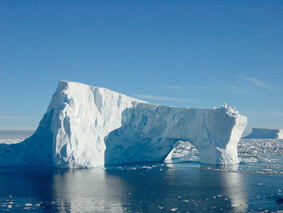
|
Published:
Clarifying polar ice and climate trends
With a steady stream of seemingly conflicting stories about melting ice sheets, expanding sea ice and sea-level rise, the complex nature of climate science makes interpreting this information extremely difficult. It turns out that ‘ice ain’t ice’.

|
|
The secret life of polar ice is a complicated tale. Credit: ACE CRC
|
Individual stories and data releases often tell only a small part of a much larger tale about the polar regions and their response to climate change. The two leading characters in this tale are sea ice and ice sheets, each with a significant but very different role in the global climate system.
Sea ice is floating ice formed from frozen ocean water and is seasonal, forming in autumn, growing during winter and melting in summer. This icy ‘skin’ is a complicated mixture of ice, snow cover and open water.
A change in sea ice volume does not affect sea level; however, sea ice plays a significant role in other aspects of the climate system, affecting the interaction between ocean and atmosphere as well as driving global ocean circulation, structuring ecosystems and providing a habitat for many wildlife species.
Ice sheets, on the other hand, are vast areas of freshwater ice overlying the land masses of the Antarctic continent and Greenland. They are formed from snowfall that has slowly compressed over decades to centuries. They flow under their own weight, ‘oozing’ slowly from the interior towards the coast where they are lost as icebergs, or as melt water runoff either at the surface or beneath floating ice shelves.
Ice sheets directly influence sea level: mass is continually added to an ice sheet by snowfall and removed by melt and iceberg calving. When the annual loss equals the annual gain the ice sheet is ‘in balance’. Any imbalance between ice gain and loss results in a sea-level change.
According to the Antarctic Climate & Ecosystems Cooperative Research Centre, until recent advances in technology it was uncertain whether the ice sheets were contributing to sea-level rise or fall. The CRC says that determining the role that the great ice sheets of Antarctica and Greenland play in future global sea level is the most pressing challenge for polar science because of the vast amount of water they hold – the majority of ice on land is stored in the ice sheets of Antarctica (88 per cent) and Greenland (11 per cent).
The CRC’s latest Position Analysis on ice sheets and sea-level rise says there is growing evidence that ice sheets in both Greenland and Antarctica are contributing more to present sea-level rise than previously estimated.
The report clarifies that the ice sheets on both continents are losing mass and contributing to sea-level rise. Ice loss has been greatest along coastal sectors of the Antarctic Peninsula and West Antarctica. However, ice thickening (gain) inland and over most of East Antarctica may have partially offset this loss. All available estimates, however, show that the loss of mass in West Antarctica is greater than any added in East Antarctica. In Greenland, the central ice sheet has thickened, but this has been more than offset by more melting near the coast.
The companion Position Analysis on sea ice and climate change says satellite sea ice measurements show that the average annual sea ice extent in the Arctic has declined, while in Antarctica changes have been more subtle and regionally variable: the western Antarctic Peninsula region shows a decline in sea ice extent while sea ice elsewhere is increasing.
So, just as it is possible to simultaneously have a drought in one part of Australia and floods in another, Arctic sea ice can be increasing at the same time as Antarctic sea ice is decreasing. One part of Antarctica can also be showing more ice with less ice in other areas.
These kinds of differences reflect not only the different geographical settings of the northern and southern hemispheres, but also the different large-scale atmospheric and oceanic processes at work in the different regions.
Material in this article was prepared using information supplied by the Australian Antarctic Division. The ACE CRC Position Analyses on sea ice and ice sheets will be released in June 2009.
More information:



